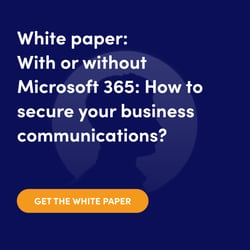How to respond to identity theft: Learnings from a real-life example
Identity theft isn’t a new threat within the cyberthreat landscape. But if you’re online (and who isn’t nowadays), it is something you need to be aware of and beware of.
Here are just a few reasons why identity theft should be on your radar right now:
- The number of identity theft cases started growing rapidly in early 2020, estimated to reach its all-time high in 2023.
- In 2022, the Federal Trade Commission (FTC) registered 1.4 million cases – that's 25% of all FTC reports.
- It’s estimated that a third of US citizens faced identity theft at some point in their lives, and the probability of a US citizen facing identity theft is 3x higher than in other countries.
If these numbers don’t convince you, L.’s first-hand experience with identity theft might.
Contents
How can identity theft occur?
How should you respond to the theft of your identity?
What are the consequences of identity theft?
How to protect yourself from identity theft?
Identity protection is a shared responsibility between individuals and organizations
How can identity theft occur?
Identity theft happens when someone steals and uses the Personal Identifying Information (PII) of someone else (like social security number, name, or home address) without their knowledge or permission.
The way to the information is much easier these days as victims tend to share their PII online, commonly without understanding the risks or consequences. The typical tactics of cybercriminals include email phishing, fake websites, impersonation scams, or account hacking (common on social media).
And the worst part? You may not know that your identity has been stolen until the moment the criminal starts using your information.
Or as in L.’s case, the criminal has been using their information already for some time before L. found out: “I realized it when I filed my taxes. I received a letter from the state treasury saying they added 43k to my income for unemployment. My accountant and I were confused, leading us to further investigate.”
How should you respond to the theft of your identity?
If your identity has been stolen or you strongly suspect it, here’s a list of steps to take, including L.’s tips:
- Contact FTC and file an identity theft report.
- Fill out a fraudulent report.
- Contact your local police and file a police report (you might need to provide a copy of the report to the credit agency).
- Contact your bank, credit agency, and other institutions to place fraud alerts and credit freeze on your accounts.
- Change your passwords for online banking and other accounts.
- Don’t forget to keep track of your activities and take notes of all conversations.
What are the consequences of identity theft?
 Typically, the goal of identity theft is financial gain. If successful, the crime affects the victim’s financial status and credit score. And as L. mentions, the situation is very inconvenient and requires many phone calls and correcting of financial records.
Typically, the goal of identity theft is financial gain. If successful, the crime affects the victim’s financial status and credit score. And as L. mentions, the situation is very inconvenient and requires many phone calls and correcting of financial records.
On top of that, the process of sorting out an identity theft case can take several weeks, and the situation can cause severe emotional and mental strains.
“The entire process, including receiving the refund check, took about a month. It was very scary, pondering what else is out there that I’m not aware of and how they got my info, my social, and credit cards,” L. points out.
How to protect yourself from identity theft?
Identity theft can happen in the digital world as well as the physical one. So, it’s important to protect your personal information equally online and offline.
Key practices include:
- Keep your information safe online. For example, don’t give out your information to an unverified source or when unsure.
- Keep your accounts safe. For example, by using strong passwords, strong identity verification, or biometric authentication options.
- Regularly check your accounts and credit card reports for any unusual activities.
- Protect any physical records that include your personal information and dispose of paper records that include your name and address appropriately.
L. summarizes: “Never take anything for granted. Be more aware and cautious with everything, like clicking on links. Having protective measures, like software that notifies you of suspicious activities, is crucial.”
Identity protection is a shared responsibility between individuals and organizations
After the identity theft incident, L. is hesitant to trust businesses and organizations (such as a healthcare provider) that handle their personal data: “I don’t trust them 100% due to not knowing what measures they are using to secure my data and protect me from identity theft.”
And L. is right, organizations sometimes fail to protect their clients’ data when they fall victim to data breaches or leaks.
To protect their customers' identity and personal data, organizations are required to comply with data privacy and protection laws and industry regulations. On top of that, many organizations opt to employ extra security measures by using secure communications and data sharing solutions.
Is your organization looking to secure your communications and data, including sensitive customer information? Check out our SalaX Secure Collaboration >>>
SalaX Secure Collaboration 2024 is a complete package of five applications that help organizations prevent data breaches by building your own authorized and secure channels to:
- Communicate securely via email, messaging app, voice and video calls, even about sensitive or confidential information
- Store and share data and files in an encrypted format
- Collect data from your customers, partners, or employees in a highly secure manner
- Securely sign documents with electronic signatures
Related content:


